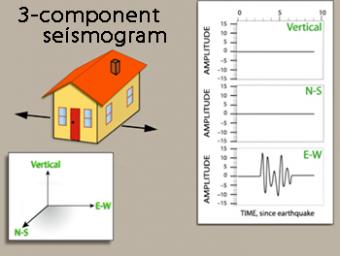3-Component Seismogram Records Seismic-wave Motion
How do we capture the motion of an earthquake?
Modern seismometers include three (3) elements to determine the simultaneous movement in three (3) directions: up-down, north-south, and east-west. Each direction of movement gives information about the earthquake. This animation shows both the movement of the three (3) basic waves (P, S, and surface) and the effect of the waves on a building. The three (3) seismograms produced by a modern seismograph station show that the P wave is more visible on the vertical component and the S wave amplitude is larger on the horizontal components.
We emphasize that seismic waves traveling away from an earthquake occur everywhere, not just at seismic stations.
CLOSED CAPTIONING: A .srt file is included with the download. Use an appropriate media player to utilize captioning.
Keypoints:
Following an earthquake:
- the ground responds to P, S, and surface waves by moving in all directions
- the motion can't be captured by a single seismometer in one direction
- three signals are received by the three components to reflect N-S, E-W, and up-down motion.



Keine Kommentare:
Kommentar veröffentlichen